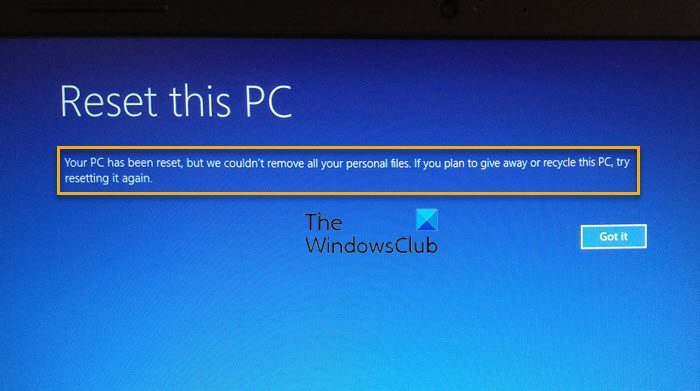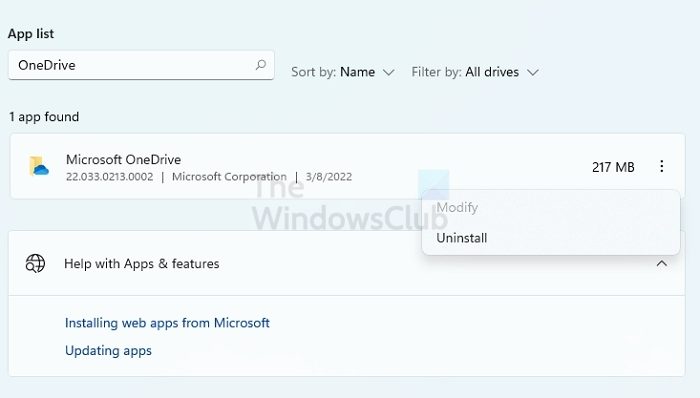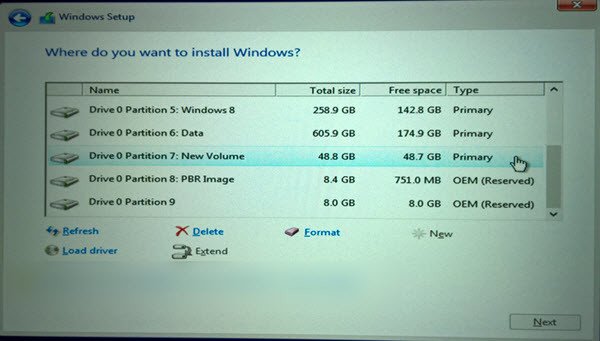When you use the Reset this PC option in Windows 11 or Windows 10 computer and opt to remove all the files, it cleans everything from the system drive. However, if you get a message at the end saying that – Your PC has been reset, but we couldn’t remove all your personal files, then this post will help you resolve the problem.

Here is the complete error message displayed once the reset is complete-
Reset this PC
Your PC has been reset, but we couldn’t remove all your personal files. If you plan to give away or recycle this PC, try resetting it again.
Windows Reset could not remove all your personal files
When Windows performs a reset, it wipes everything and prepares the PC to be transferred to someone else. The method ensures the data is not recoverable. However, with this error, your files are still available. So what do we do? The answer is simple: you need to perform a reset again, but you need to resolve the problem before that.
- Update your PC
- Remove OneDrive and Office Apps
- Disconnect External drives
- Clean install Windows
- Use OEM Recovery
Before you go ahead, make sure to take a backup of existing files on the PC.
1] Update your PC
Manually update your Windows 11 PC and install the available updates if any. There was a recent bug where Resetting a Windows 11 device did not delete all files. This has been fixed now.
2] Remove OneDrive and Office Apps
OneDrive comes pre-installed in Windows, and since most of the users connect it with a Microsoft account, the app keeps running in the background. If, during the cleanup, the files are not synced completely or locked, then Windows will not delete them. The same applies to Office apps which make sure the files are correctly synced.
If the Reset still has your account in place, then login into it or create any local account. You can then uninstall OneDrive, Office apps and manually delete the files. Post this, you can perform the reset again, which should help you resolve it.

To uninstall, Go to Settings > Apps and uninstall the apps. You can then use File Explorer to delete any files in the User folders.
3] Disconnect External drives
All external drives connected to the PC must be disconnected. Anything on the drive-in use will result in blocking, and Windows will not remove those files. There can be a hardware-related issue as well that can add to the problem. It would be best to disconnect all external drives and then initiate the reset procedure.
4] Clean install Windows

If nothing works out, the easy way is to reinstall Windows using a bootable USB Drive. It will be similar to installing Windows, but you get the option to format the system partition and then install Windows. When following this method, the process will not be blocked by anything. The result will be the same, but it may take longer to complete.
The process includes downloading the Media Install from the Microsoft website and then using the installer to prepare a bootable drive. Done that, you can boot the PC from the USB drive and then clean install Windows.
TIP: You can also reset Windows without using the Settings app.
5] Use OEM Recovery
Most OEMs offer a built-in recovery method that doesn’t get blocked by any other program or files in sync. While Windows needs to honor such conditions, OEM software can skip and easily format the drive and reinstall Windows. While the method works, it will bring back apps, bloatware, and drivers that you had the PC for the first time. Also, it may not be the latest version of Windows.
To use OEM recovery, look for OEM Software on your Desktop or the Start Menu. Launch it, and then follow the wizard to restore the Factory Image to your PC.
Related: There was a problem resetting your PC
What will Reset this PC do in Windows?
Reset this PC will delete everything on the system partition and reinstall Windows again. It will remove files, user accounts, applications, and anything else. It will be as good as setting up your Windows PC for the first time.
Is it safe to reset the PC?
If you have issues on Windows PC that you cannot fix, you can choose to reset the PC while keeping the document. If you give it to someone else, reset it without keeping the files. In either case, the process is safe and helps you start over and fix all the problems related to corrupt system files.
Leave a Reply